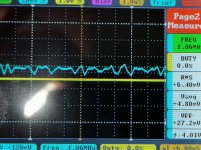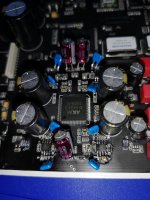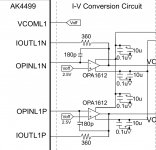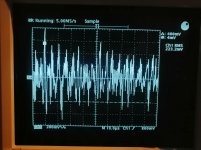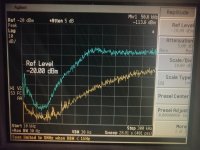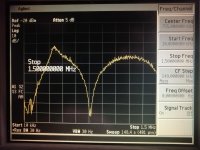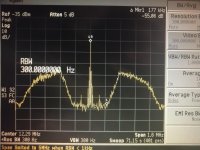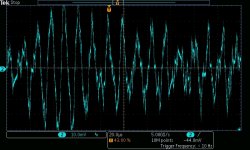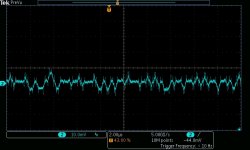I have a Gustard A18 and had been playing with different opamp for the IV. The original lme49860 actually sounded quite good with a thick warm sound as compare to my other Topping es9038pro dac but not as detailed. So I want to see if there are better opamps. First to try was opa1656, didn't work, sound too sharp. I measure iv opamp output with a cheap dso scope (can only do min 20mv and 1uS) and saw a huge amount of noise 38mV at around 1.3mhz. Next tried ada4610, much better but still have 7.2mV at 1.2mhz.
Next is opa1612, very similar to ada4610.
Just wonder if the noise at the iv opamp has any meaning and should I play with the 180pf IV filter cap to lower the noise?
Next is opa1612, very similar to ada4610.
Just wonder if the noise at the iv opamp has any meaning and should I play with the 180pf IV filter cap to lower the noise?
Attachments
Last edited:
The opamp AKM uses for AK4499 I/V is OPA1612. Only reason I could think of for using LME49860 would be if the opamp power rails are too high for OPA1612. Actually, for use with AK4499, Topping chose +-11v power rails for the OPA1612 opamps. Seems to help lower distortion is the particular application.
The extra detail perceived from ES9038PRO is often caused by its distortion, much like the way an 'harmonic exciter' plugin works to create false detail that's not really in a recording.
The extra detail perceived from ES9038PRO is often caused by its distortion, much like the way an 'harmonic exciter' plugin works to create false detail that's not really in a recording.
Last edited:
The Gustard also uses +/- 11v. I guess that's common for ak4499 as my Topping dx7 pro es9038 uses +/-9V regulated down from a +/-13v input.
I feel the lme49860 has a relatively warm thick sound that some will like. I have put the lme49860 in the lpf position of the Topping and it also sound thicker than other opamp I tried. So I might put back the lme if I get tire of the opa1612, unfortunately the smd pad can not take too make resoldering.
For the Gustard, there is one must do mod which is replacing the 2 x 680R I/V in 0603 smd. My guess for using two 680R i/v resistor instead of one is to give better accuracy? Anyways, I replace it with one 340R blue bulk foil Vishay AE 0.05% resistor and it give a noticeable improvement in sound. So I/V resistor here do make a difference.
Now I wonder if I can tweak the sound by changing the filter cap in the I/V opamp, that uses 180pf same as the datasheet. I piggyback a 10nf on the existing 180pf and measured the i/v opamp output and got lower fz and output noise. So I wonder how do I calculate the value of roll off for that capacitor?
I feel the lme49860 has a relatively warm thick sound that some will like. I have put the lme49860 in the lpf position of the Topping and it also sound thicker than other opamp I tried. So I might put back the lme if I get tire of the opa1612, unfortunately the smd pad can not take too make resoldering.
For the Gustard, there is one must do mod which is replacing the 2 x 680R I/V in 0603 smd. My guess for using two 680R i/v resistor instead of one is to give better accuracy? Anyways, I replace it with one 340R blue bulk foil Vishay AE 0.05% resistor and it give a noticeable improvement in sound. So I/V resistor here do make a difference.
Now I wonder if I can tweak the sound by changing the filter cap in the I/V opamp, that uses 180pf same as the datasheet. I piggyback a 10nf on the existing 180pf and measured the i/v opamp output and got lower fz and output noise. So I wonder how do I calculate the value of roll off for that capacitor?
The extra detail perceived from ES9038PRO is often caused by its distortion, much like the way an 'harmonic exciter' plugin works to create false detail that's not really in a recording.
Would you like to point out a source for measurements that identify this "distortion"?
Would you like to point out a source for measurements that identify this "distortion"?
It's purely his opinion, with nothing to substantiate it.
To the OP - how are you measuring this? What do your scope probe connections look like? It's possible this is a measurement artifact. What is the sample rate of this DSO also?
Last edited:
It's purely his opinion, with nothing to substantiate it.
To the OP - how are you measuring this? What do your scope probe connections look like? It's possible this is a measurement artifact. What is the sample rate of this DSO also?
It's a DSO212 with the following spec
Max sample rate: 10MSa/s
Analog bandwidth: 1MHz
Max sample memory depth: 8K
Analog input impedance: 1MΩ
Max input voltage: ±40V(X1 probe)
Coupling:AC/DC
Vertical sensitivity: 20mv/Div~10V/Div (1-2-5 sequence step)
Horizontal sensitivity: 1uS/Div~2S/Div(1-2-5 sequence step)
I don't think it's a measurement artifact as I did the same at the lpf opamp output and it's clean. I also measure the Topping es9038 i/v opamp output also clean. I clip ground to output ground and probe the i/v opamp output directly.
with the opa1612 in place, it is actually fairly close to the i/v from the ak4499 datasheet, except the i/v resistor value is 340R and decoupling cap only has 47nf COG running on +/-11V.
The +/-11v supplies is from Ti very low noise tps7a47 and tps7a33. I also tweaked that to 100nf cog and Silmic cap at the output. Before I used ultra low esr polymer tan in that position and it didn't sound very good, so I put audio grade cap back instead.
The +/-11v supplies is from Ti very low noise tps7a47 and tps7a33. I also tweaked that to 100nf cog and Silmic cap at the output. Before I used ultra low esr polymer tan in that position and it didn't sound very good, so I put audio grade cap back instead.
Attachments
Uhm.. I have been looking at the output of the I/V converters in my 4499 dac.
See below the noise levels, and spectra.
I would say, if You don't see humongous amounts of noise there, - then something is very wrong in the system..
See below the noise levels, and spectra.
I would say, if You don't see humongous amounts of noise there, - then something is very wrong in the system..
Attachments
Chuck, having done some back to back level matched with the smsl400 and A18 I agree with you, theres a fullness and bloom to the bass on the A18 that doesnt sit right. Neither the smsl, or my 9038 dac have this.
I love the dac otherwise, but id like to remove this 'effect.
I love the dac otherwise, but id like to remove this 'effect.
IMHO:
I find it to be nonstationary relative to typical audio FFTs.
Your more or less HO could make sense if you could explain the meaning of the above quote.
It is not the first time you are using the concept of “non stationary distortion” which, to me, makes sense only in the case of a time variant circuit, which, for all purposes, a DAC is not, neither is the possible op amp input stage demodulation of RF ingress. Otherwise, nonlinearities do NOT create non harmonic spectral components.
Explanation without techno-babble, please.
Last edited:
I don't know for the noise as I am a coocker !
So the Elna violette is like a sugar - often good as main cap in front of such Ts7a regs btw- and if you don't get smooth with them as 10 uF cap with the opa1612 better to give up the 1612 -you could as well try to swap the 47 nF with something else as a PPS smd cap from Panasonic to be sure instead of the C0G- I don't know what are the main black caps but with the opa1612 if they are local power decoupling cap and if still with the opa1612 I will try those same violett Elna there...a not known enough cap imo that can help often.
I yet will give a chance to the LME but instead of the violett Elna I will putt Panasonic FC or Nichicon green bipolar to see if the extra clarity add subjectivly more clearness/details. The caps will not solve the noise, the difference will be not as changing the oap but can subjectivly accomodate the sounds to a better trade off you may like more and be good enough if you like most of the quality of the dac sound already... -it should be possible to coock the LME more on the light side -
What is please the black caps with gold line on your board ? Nichicons or Panasonics or ???
Well it's just snake oil oil coocking... forgett it if not of that church
So the Elna violette is like a sugar - often good as main cap in front of such Ts7a regs btw- and if you don't get smooth with them as 10 uF cap with the opa1612 better to give up the 1612 -you could as well try to swap the 47 nF with something else as a PPS smd cap from Panasonic to be sure instead of the C0G- I don't know what are the main black caps but with the opa1612 if they are local power decoupling cap and if still with the opa1612 I will try those same violett Elna there...a not known enough cap imo that can help often.
I yet will give a chance to the LME but instead of the violett Elna I will putt Panasonic FC or Nichicon green bipolar to see if the extra clarity add subjectivly more clearness/details. The caps will not solve the noise, the difference will be not as changing the oap but can subjectivly accomodate the sounds to a better trade off you may like more and be good enough if you like most of the quality of the dac sound already... -it should be possible to coock the LME more on the light side -
What is please the black caps with gold line on your board ? Nichicons or Panasonics or ???
Well it's just snake oil oil coocking... forgett it if not of that church
I would repeat: there is no "noise problem" to risolve.
The extremely high noise on the I/V output is there by design; it must be there. If that is missing, now that's a problem! The output is noise shaped like in the shots below. That must be resolved all ok by the following stage, then the desired level of distortion and noise in the output (after differential summing/filtering) can be achieved..
The 4499 does not have the usual built in switched capacitor filter. It should be handled externally.
Ciao, George
The extremely high noise on the I/V output is there by design; it must be there. If that is missing, now that's a problem! The output is noise shaped like in the shots below. That must be resolved all ok by the following stage, then the desired level of distortion and noise in the output (after differential summing/filtering) can be achieved..
The 4499 does not have the usual built in switched capacitor filter. It should be handled externally.
Ciao, George
Attachments
Uhm.. I have been looking at the output of the I/V converters in my 4499 dac.
See below the noise levels, and spectra.
I would say, if You don't see humongous amounts of noise there, - then something is very wrong in the system..
Thanks for confirming its normal to have noise at the i/v opamp output. I also have found in another forum to show the same noise as well.
Chuck, having done some back to back level matched with the smsl400 and A18 I agree with you, theres a fullness and bloom to the bass on the A18 that doesnt sit right. Neither the smsl, or my 9038 dac have this.
I love the dac otherwise, but id like to remove this 'effect.
I believe its the sound of the LME49860, it does sound thicker than other opamp. Or if u can do smd work, u can replace it with the opa1612 or ada4610 which will tighten up the sound. Depending on music, I sometimes do prefer the thicker sound from the LME opamp.
BTW, replacing those two 680R iv resistor will bring a nice improvement and improve the bit of bloom to the sound.
Yes there is a reasonable amount of noise on the output of the AK4499. This is all high up in frequency and gets filtered out by the low pass filter that comes after the IV stage.
The trouble/tricky part here is that the IV opamp used must be of high enough speed to pass this noise without running into problems (slewing?). If the opamps speed limits are exceeded you see additional broadband noise on the output.
The IV capacitor is effective at bandwidth limiting the IV section, but to make other opamps happy you would need to increase its value. Trouble is doing this increases the distortion on the output of the IV stage as the opamps output is more heavily loaded.
At least this is my guess. I tried a bunch of different opamps when building my ak4499s. More for points of comparison than expecting them to be suitable. The slower opamps all had increased broadband noise on the output.
I didn't actually bother to increase the IV cap size to fix it as this would screw up the distortion performance. I just deemed them unsuitable. This included the OPA1622 with its amazing current driving capacity. It's not the fastest chip though.
The OPA1612 wasn't chosen arbitrarily by AKM. I've tried the ADA4898 too. Initially this is what I started with as I had them on hand. No go. The devil is in the details. While they are excellent opamps they are incapable of the levels of performance the 1612 can achieve.
So what goes wrong with the 4898? It shows a significantly higher amount of distortion at high frequencies when the DAC is driven hard. In other words when the opamp is having to swing appreciable voltages on its output it falls apart at higher audio frequencies. Yes it's capable of driving the capacitive load, yes it's capable of driving the punishing 360ohm load but not quite as elegantly as the 1612.
The datasheet implies that the 4898 has been created more for high linearity with difficult loads but at smaller swings on its output stage. Most of its graphs characterise it as such. Vs the 1612 that has its characteristics shown at higher drive levels.
Either way this doesn't matter. The point is the AK4499 demands a lot when it comes to the IV stage. It's almost like AKM picked the 1612 as one of the most linear opamps, over the range they wanted to use it, then designed the limits of the AK4499 to match.
Maybe one of the national parts would give it a run for its money, but why bother? The 1612 is low noise, low distortion, fast enough, lower than others in power consumption and is a very well known quantity, we know it to work in the given application. It's also not ridiculously expensive.
The trouble/tricky part here is that the IV opamp used must be of high enough speed to pass this noise without running into problems (slewing?). If the opamps speed limits are exceeded you see additional broadband noise on the output.
The IV capacitor is effective at bandwidth limiting the IV section, but to make other opamps happy you would need to increase its value. Trouble is doing this increases the distortion on the output of the IV stage as the opamps output is more heavily loaded.
At least this is my guess. I tried a bunch of different opamps when building my ak4499s. More for points of comparison than expecting them to be suitable. The slower opamps all had increased broadband noise on the output.
I didn't actually bother to increase the IV cap size to fix it as this would screw up the distortion performance. I just deemed them unsuitable. This included the OPA1622 with its amazing current driving capacity. It's not the fastest chip though.
The OPA1612 wasn't chosen arbitrarily by AKM. I've tried the ADA4898 too. Initially this is what I started with as I had them on hand. No go. The devil is in the details. While they are excellent opamps they are incapable of the levels of performance the 1612 can achieve.
So what goes wrong with the 4898? It shows a significantly higher amount of distortion at high frequencies when the DAC is driven hard. In other words when the opamp is having to swing appreciable voltages on its output it falls apart at higher audio frequencies. Yes it's capable of driving the capacitive load, yes it's capable of driving the punishing 360ohm load but not quite as elegantly as the 1612.
The datasheet implies that the 4898 has been created more for high linearity with difficult loads but at smaller swings on its output stage. Most of its graphs characterise it as such. Vs the 1612 that has its characteristics shown at higher drive levels.
Either way this doesn't matter. The point is the AK4499 demands a lot when it comes to the IV stage. It's almost like AKM picked the 1612 as one of the most linear opamps, over the range they wanted to use it, then designed the limits of the AK4499 to match.
Maybe one of the national parts would give it a run for its money, but why bother? The 1612 is low noise, low distortion, fast enough, lower than others in power consumption and is a very well known quantity, we know it to work in the given application. It's also not ridiculously expensive.
Chuck, having done some back to back level matched with the smsl400 and A18 I agree with you, theres a fullness and bloom to the bass on the A18 that doesnt sit right. Neither the smsl, or my 9038 dac have this.
I love the dac otherwise, but id like to remove this 'effect.
I don't know for the noise as I am a coocker !
So the Elna violette is like a sugar - often good as main cap in front of such Ts7a regs btw- and if you don't get smooth with them as 10 uF cap with the opa1612 better to give up the 1612 -you could as well try to swap the 47 nF with something else as a PPS smd cap from Panasonic to be sure instead of the C0G- I don't know what are the main black caps but with the opa1612 if they are local power decoupling cap and if still with the opa1612 I will try those same violett Elna there...a not known enough cap imo that can help often.
I yet will give a chance to the LME but instead of the violett Elna I will putt Panasonic FC or Nichicon green bipolar to see if the extra clarity add subjectivly more clearness/details. The caps will not solve the noise, the difference will be not as changing the oap but can subjectivly accomodate the sounds to a better trade off you may like more and be good enough if you like most of the quality of the dac sound already... -it should be possible to coock the LME more on the light side -
What is please the black caps with gold line on your board ? Nichicons or Panasonics or ???
Well it's just snake oil oil coocking... forgett it if not of that church
The smd pad is in the 0805 size and I can't fit much to them. I can try piggyback on the 0805 ceramic with some ecap/solid polymer but not much space.
The 4 big cap around the ak4499 is Nichicon KW 1000uf/35v. I am thinking of replacing them with some low esr cap as it decouples the very important VRef . The KW is follow by a 0603 ceramic of unknown value to the VRef. The datasheet shows a 2200uf + 0.1uf to be use there.
large ou
It's a little bit surprising for me that AK4499 has such huge out of band noise(post 16) because it's multibit topology. As long as I know, AK4499 uses 3rd order multibit DSM. Even if 1bit DSM, you can have less residual noise with 8th order DSM(64OSR),pic1. If your HW can accept 128OSR, 5th order DSM is available, then far less noise(pic2).
It's a little bit surprising for me that AK4499 has such huge out of band noise(post 16) because it's multibit topology. As long as I know, AK4499 uses 3rd order multibit DSM. Even if 1bit DSM, you can have less residual noise with 8th order DSM(64OSR),pic1. If your HW can accept 128OSR, 5th order DSM is available, then far less noise(pic2).
Attachments
- Home
- Source & Line
- Digital Line Level
- Ak4499 noise at iv opamp output
